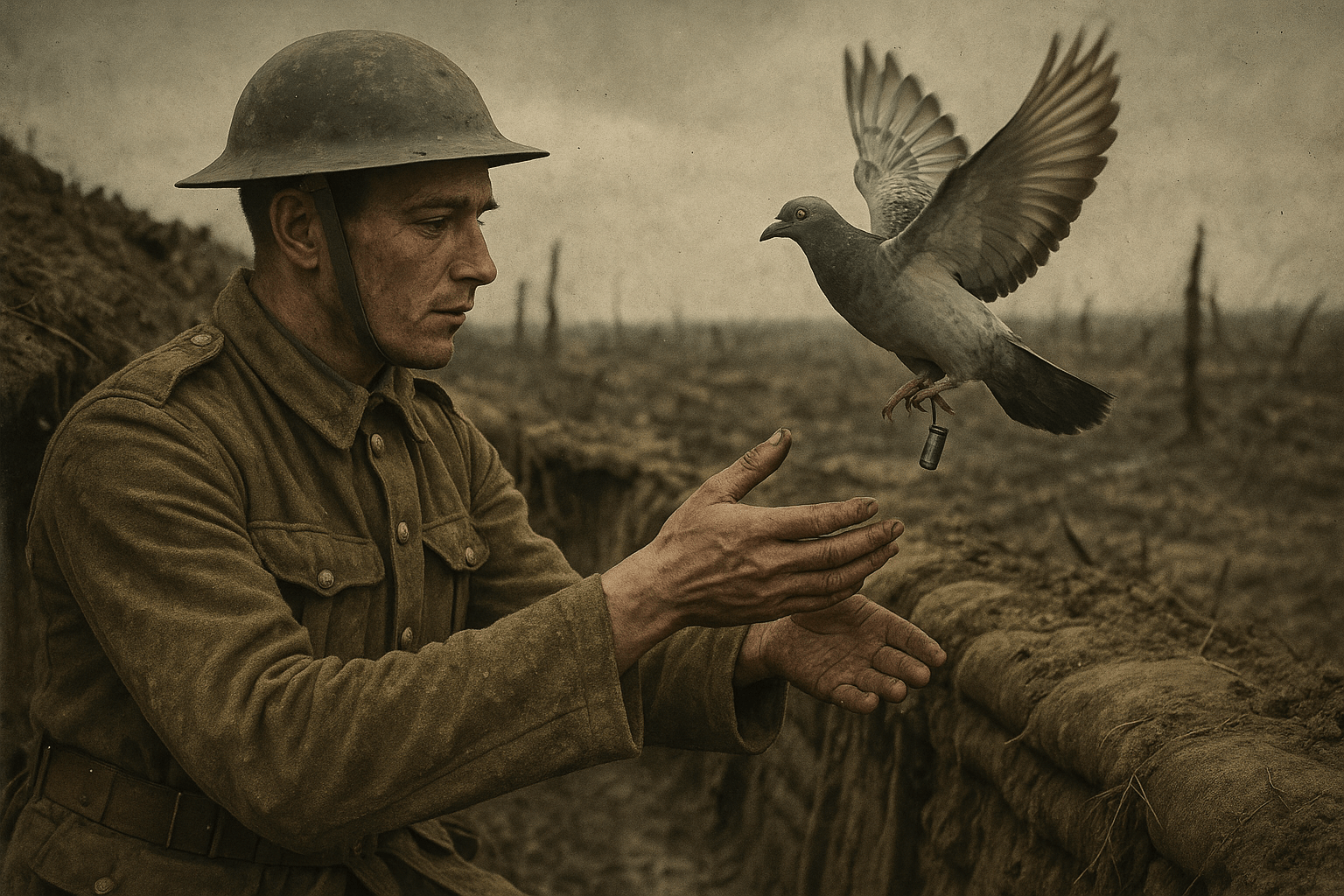A Low-Tech Solution to a High-Tech Problem
As World War I descended into the grinding stalemate of trench warfare, communication became a life-or-death struggle. Field telephone lines, the primary means of connecting the front lines to command posts, were a spiderweb of wires that were constantly being severed by the relentless artillery bombardments. Human runners were brave, but they were slow, highly visible targets, and their chances of crossing the shell-cratered “No Man’s Land” were frighteningly slim. Early radio technology, meanwhile, was bulky, unreliable, and easy to intercept.
Military commanders on all sides—British, French, German, and American—turned to a proven method: the homing pigeon. These birds were not simply released to fly in a general direction. They were raised in a specific loft, which they considered their home. Soldiers would carry these pigeons to the front lines in baskets or in mobile lofts (often built into converted buses). When a message needed to be sent, it was written on a slip of thin paper, rolled up, and placed into a tiny aluminum canister attached to the pigeon’s leg. Once released, the bird’s powerful homing instinct would drive it to fly back to its loft, often many miles behind the front lines, at speeds averaging 60 miles per hour.
The Pigeon Signal Corps
What started as a niche idea quickly became a massive, organized effort. The Allied forces alone employed over 500,000 pigeons during the war. These birds were considered soldiers. They were specially trained, cared for by handlers known as “pigeoneers”, and officially enlisted in the Signal Corps. The job was not for the faint of heart. Pigeons faced a myriad of dangers:
- Enemy Fire: Soldiers were trained to shoot down enemy pigeons, knowing they carried valuable intelligence.
- Birds of Prey: The enemy sometimes used trained hawks and falcons to intercept the messengers mid-flight.
- Exhaustion and Weather: Pigeons flew through rain, wind, and clouds of poison gas, navigating by instinct over a landscape torn apart by war.
Despite these risks, the success rate was astonishing. It is estimated that over 95% of messages sent by pigeon were successfully delivered, making them the most secure form of communication of the entire war.
Cher Ami: The Hero of the “Lost Battalion”
Of all the feathered heroes of WWI, none is more famous than Cher Ami. This Black Check Cock carrier pigeon, donated by British pigeoneers to the U.S. Army Signal Corps, was destined for greatness.
In October 1918, during the brutal Meuse-Argonne Offensive, Major Charles Whittlesey and over 550 men of the U.S. 77th Infantry Division pushed too far, too fast. They found themselves completely surrounded by German forces in the Argonne Forest, cut off from all supplies and reinforcements. This group would become immortalized as the “Lost Battalion.”
As German attacks intensified, Whittlesey’s position became desperate. To make matters worse, their location was incorrectly plotted by Allied command. American artillery, believing it was firing on the enemy, began raining shells down directly on the trapped men. With his telephone lines cut and his runners unable to get through, Whittlesey turned to his last hope: his pigeons.
He sent his first pigeon with a plea to stop the friendly fire. It was shot down almost immediately. A second bird was sent. It, too, fell from the sky. Only one pigeon remained: Cher Ami. With trembling hands, a soldier attached the crucial message:
“We are along the road parallel to 276.4. Our own artillery is dropping a barrage directly on us. For heaven’s sake, stop it.”
As Cher Ami took to the sky, German soldiers opened fire. The Americans watched in horror as the bird was hit and tumbled towards the ground. But then, miraculously, he righted himself and flew on. Covered in blood, he powered through the sky. He flew 25 miles in just 25 minutes, arriving at his loft at division headquarters. The pigeoneers who retrieved him were shocked. Cher Ami had been shot through the breast, was blinded in one eye, and one of his legs was hanging on by a single tendon, the vital message canister dangling from it.
The message was delivered. The artillery was stopped. Reinforcements were sent to the battalion’s correct location, and the 194 surviving men of the “Lost Battalion” were saved. Cher Ami became a national hero. Army medics managed to save his life but could not save his leg, which they replaced with a small, carved wooden one. He was awarded the French Croix de Guerre with a palm frond for his gallantry. When he died a year later, his body was preserved and is now on display at the Smithsonian’s National Museum of American History, a permanent testament to his bravery.
An Enduring Legacy
Cher Ami was not an isolated case. Another pigeon, “President Wilson”, was grievously wounded while delivering a message that was vital to a U.S. infantry advance in November 1918. A British pigeon named “The Mocker” flew 52 missions before being wounded on his last, successfully delivering coordinates that silenced enemy artillery. These birds were so vital that deliberately killing a homing pigeon was a court-martial offense.
The story of the war pigeons is a poignant reminder that in a conflict defined by industrial might, courage and determination can be found in the most unexpected of forms. These small birds, flying through a storm of steel and fire, carrying messages of desperation and hope, saved thousands of lives. They remain a powerful symbol of duty and sacrifice, the unsung, winged soldiers of the Great War.
